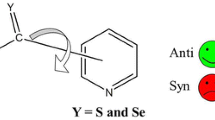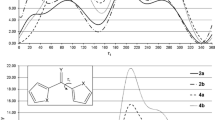Summary
Ground state structures and conformational interconversion mechanisms of 25 diaryl compoundsAr 2 Z (Z=CH2, CHR, CH(OH), P-CH3) were analyzed. For tetra(ortho-alkyl)substituted diaryls the cogwheeling mechanism was found as the threshold mechanism. A shift from the cogwheeling mechanism to interconversions via 2-ring flips is found in di(ortho-alkyl)substituted compounds. The ground state structures and interconversion mechanisms of diarylmethylphosphines are very similar to those of the related 1,1-diarylethanes. The interconversion barrier for correlated conrotation of the aryl rings in di(tert-butylphenyl)methanol (20) was measured by low temperature NMR and is in excellent agreement with the calculated value for the 2-ring flipT″2 (ΔG≠ (exp.)=48 kJ mol−1; ΔG≠ (calc.)=54 kJ mol−1).
Zusammenfassung
Die Grundzustandskonformationen und die konformativen Interkonversions-mechanismen von 25 DiarylverbindungenAr 2 Z (Z=CH2, CHR, CH(OH), P-CH3) wurden analysiert. Für tetra(ortho-alkyl)substituierte Diaryle wurde der cogwheeling-Mechanismus als der Interkonversionsmechanismus niedrigster Energie ermittelt. In di(ortho-alkyl)substituierten Verbindungen werden nicht der cogwheeling-Mechanismus sondern 2-ring flips als Interkonversionsmechanismen gefunden. Die Grundzustände und Interkonversionsmechanismen für Diarylmethylphosphine sind sehr ähnlich jenen der verwandten 1,1-Diarylethane. Die Interkonversionsbarriere für die korrelierte Bewegung der Arylringe von Di(tert-butylphenyl)methanol (20) wurde mittels Tieftemperatur-NMR-Spektroskopie ermittelt und ist in sehr guter Übereinstimmung mit dem berechneten Wert für den 2-Ring flipT″2 (ΔG≠ (exp.)=48 kJ mol−1; ΔG≠ (calc.)=54 kJ mol−1).
Similar content being viewed by others
References
Mislow K. (1989) Chemtracts-Org. Chem.2: 151
Willem R., Gielen M., Hoogzand C., Pepermans H. (1985) In: Gielen M. F. (ed.) Advances in Dynamic Stereochemistry, Vol. 1, ch. 5. Freud Publishing House, London
Mislow K. (1976) Acc. Chem. Res.9: 26
Weissensteiner W., Scharf J., Schlögl K. (1987) J. Org. Chem.52: 1210
Lauer D., Staab K. A. (1969) Chem. Ber.102: 1631
Finnochiaro P. (1975) Gazz. Chim. Ital.105: 149
Ackerman O. S., Coops J. (1967) Rec. Trav. Chem. Pays-Bas86: 55
Akkerman O. S. (1970) Rec. Trav. Chim. Pays-Bas89: 673
Lam W. Y., Martin J. C. (1981) J. Org. Chem.46: 4458, 4462
Biali S. E., Nugiel D. A., Rappoport Z. (1989) J. Am. Chem. Soc.111: 846
Schlögl K., Weissensteiner W., Widhalm M. (1982) J. Org. Chem.47: 5025
Finnochiaro O., Gust D., Hounshell W. D., Hummel J. P., Paravina P., Mislow K. (1976) J. Am. Chem. Soc.98: 4945
Iwamura H., Mislow K. (1988) Acc. Chem. Res.21: 175
Bergman J. J., Chandler W. D. (1972) Can. J. Chem.50: 353
Hounshell W. D., Iroff L. D., Iverson D. J., Wroczynsky R. J., Mislow K. (1980) Isr. J. Chem.20: 65
Iroff L. D., (1979) Ph. D. Thesis, Princeton University
In a previous paper [4] we have used the term conrotatory for the cogwheeling effect (1-ring flips) and disrotatory for 2-ring and 0-ring flips. To avoid difficulties with triarylsystemsAr 3 X the terms correlated disrotation (associated with the 1-ring flip) and correlated conrotation (2-ring flip and 0-ring flips) are used in this paper [1].
Gust D., Mislow K. (1973) J. Am. Chem. Soc.95: 1535
Mannschreck A., Ernst L. (1971) Chem. Ber.104: 228
Hunter G., McKay R. L., Kremminger P., Weissensteiner W. (1991) J. Chem. Soc., Dalton Trans.: 3349
Siegel J., Gutiérrez A., Schweizer W. B., Ermer O., Mislow K. (1986) J. Am. Chem. Soc.108: 1569
Rapport Z., Biali S. E., Kaftory M. (1990) J. Am. Chem. Soc.112: 7742
Akkerman O. S. (1967) Rec. Trav. Chim. Pays-Bas86: 1018
Allinger N. L. Quantum Chemistry Program Exchange No MM2 (87), Indiana University, Bloomington, Indiana, IN 47405, U. S. A.
Nachbar R. B., Mislow K. Quantum Chemistry Program Exchange No 514, Indiana University, Bloomington, Indiana, IN 47405, U. S. A.
Author information
Authors and Affiliations
Rights and permissions
About this article
Cite this article
Weissensteiner, W. Correlated rotation of aryl substituents in diarylmethyl-, diarylphosphine- and related fragments. An empirical force field study. Monatsh Chem 123, 1135–1147 (1992). https://doi.org/10.1007/BF00808276
Received:
Accepted:
Issue Date:
DOI: https://doi.org/10.1007/BF00808276




